|
              
THE ANIALARRA 2000 EXPEDITION
Results
  
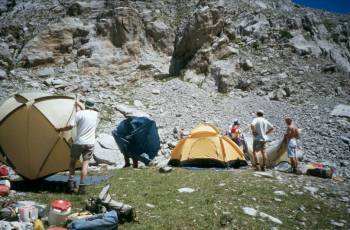 Members
of 5 different clubs participated in the Anialarra Interclub 2000: 15 members
from SC Avalon (the organizing club), 9 from Speleo Holland, 1 from Styx,
1 from Technico, and one member of the french club GS Rennes. The expedition
lasted for the whole month of August. Members
of 5 different clubs participated in the Anialarra Interclub 2000: 15 members
from SC Avalon (the organizing club), 9 from Speleo Holland, 1 from Styx,
1 from Technico, and one member of the french club GS Rennes. The expedition
lasted for the whole month of August.
There were two main objectives. The first was a serious attempt to get
passed the actual terminus of the Anialarra System (blocked by an important
boulder choke at -650m), the second was to resurvey as much as possible
of this cave system.
Besides these two objectives, we would also continue our prospections
and explorations in other caves of the Anialarra zone.
After the inevitable first days of carrying loads of gear up the mountain,
the surface camp was installed at an altitude of 2100m. The Pozo Ibarra
cave, that we discovered last year, was rigged and would be our access to
the cave system. In the cave system, two underground camps were set up:
"Camp 1" at -576 m; and "Camp 2" at -578 m; only 2 metres deeper but about
1 kilometre downstream of Camp 1, behind a long series of low water passages.
Camp 1 would be the home base for the survey teams, Camp 2 for the teams
that would attack the terminus of the cave. Each camp provided shelter for
two persons. The altitude camp, near the cave entrance, could host 6 persons.
Survey teams went underground for two days, the bottom-teams for 3 days.
In order to prevent the camps from being "overbooked", but also to optimize
their use, a rather complex and strict planning was made and applied.
Results of the bottom-teams
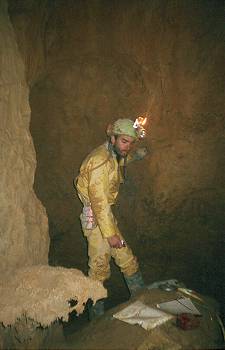 The
first team (Rudi/Paul) installed the camp at -578 m, after levelling by
hand a small platform (2x2 m) in the middle a giant heap of boulders! Then
the wireless cave radio (Heyphone) was installed and tested, in cooperation
with a surface team of course. Then this team checked the terminus of the
cave, which is an enormous boulder choke that completely blocks the entire
cave passage. It was possible to climb between the boulders, to a height
of at least 30 m., but the situation was dangerously unstable. No way on
could be found, however the very strong draught of the cave knows the way...
After having risked his life for at least two hours, Paul decided that it
would be suicide to start any digging works here. The
first team (Rudi/Paul) installed the camp at -578 m, after levelling by
hand a small platform (2x2 m) in the middle a giant heap of boulders! Then
the wireless cave radio (Heyphone) was installed and tested, in cooperation
with a surface team of course. Then this team checked the terminus of the
cave, which is an enormous boulder choke that completely blocks the entire
cave passage. It was possible to climb between the boulders, to a height
of at least 30 m., but the situation was dangerously unstable. No way on
could be found, however the very strong draught of the cave knows the way...
After having risked his life for at least two hours, Paul decided that it
would be suicide to start any digging works here.
The second team (Mark/Karl) checked the area around the terminus and
found a shaft, which seemed at least 25 m high and could only be scaled
artificially. It looked promising enough....
This teams surveyed over 500 m of cave, between the terminus and Camp
2.
Team 3 was Rudi and Paul again. They started an artificial climb in the
shaft, a difficult and slow undertaking because the walls were very loose
and unstable, and the cave was very cold too. They used a Ryobi hammer drill,
propelled by a small two-stroke engine, and this certainly didn’t simplify
their climb. At a height of 21 m., a horizontal level of fossil galleries
was found (but the shaft still goes up, for at least another 20 m). The
next day was spend here, exploring this level, which proved to be important
and very ventilated. One part of it went in the right direction, and so
the terminus of the cave was in fact passed. A bit of a disappointment followed
when they discovered traces of somebody who had visited a part of these
galleries, by climbing up to a "window" that was situated at a height of
+5 m, in the same shaft as they had climbed 21m! This window also gave access
to the same fossil level of galleries. But, the person(s) had missed 2/3
of the galleries, that were "hidden" after a small and narrow gallery.
The last day of their stay, this team held a marathon survey session
and surveyed 600 m between their Camp 2 and the low and long "ducks" upstream.
The fourth and last team (Mark/Tom) did another serious attempt to find
the way on in the new fossil level. They added another 50 m. but then everything
got too narrow to be continued without blasting or digging works. This team
then dismantled the Camp.
The newly discovered part measures 420 m in length, of which 320 m has
been surveyed, and at least 300 m can be considered as "virgin passages".
It passes the old terminus for at least 50 m, in the right direction (downstream),
and with a good airflow in that same direction. But, it’s situated some
40 m. higher than the actual river level. Still, it presents a realistic
possibility to give access to the downstream part of the Anialarra System
one day, after some digging works!
Results of the survey teams
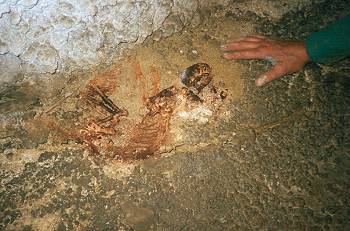 Several
survey-teams went down for 1 or 2 days to re-survey as much as possible.
The complete downstream main drain was re-surveyed (from base Pozo Ibarra
to bottom of the cave); and upstream a big part was done as well; up to
the junction with the AN6 (Pozo de Frontenac). A total of 4 km was surveyed.
During these descents, a very decorated side-gallery was discovered, Galerie
du Squelette, about 150 m long. At the beginning of this new gallery, an
amazing find was done: the skeleton of an animal (size of a cat)! It is
a mystery how this creature survived falling down at least 350 m of pitches.
It is located at a dry spot, high above the river, not at the foot of a
pitch, so the animal probably got down alive and managed to stroll around
in the cave before dying... Several
survey-teams went down for 1 or 2 days to re-survey as much as possible.
The complete downstream main drain was re-surveyed (from base Pozo Ibarra
to bottom of the cave); and upstream a big part was done as well; up to
the junction with the AN6 (Pozo de Frontenac). A total of 4 km was surveyed.
During these descents, a very decorated side-gallery was discovered, Galerie
du Squelette, about 150 m long. At the beginning of this new gallery, an
amazing find was done: the skeleton of an animal (size of a cat)! It is
a mystery how this creature survived falling down at least 350 m of pitches.
It is located at a dry spot, high above the river, not at the foot of a
pitch, so the animal probably got down alive and managed to stroll around
in the cave before dying...
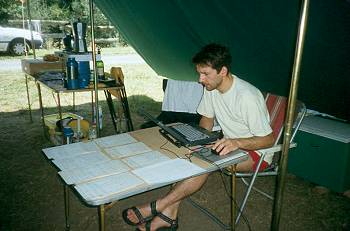 Right
now, about 6,3 km of the estimated total of 10,3 km of the cave system have
been re-surveyed. The biggest job remains re-surveying the other 3 entrances:
Pozo Estella, Pozo de los Acuarios and Pozo de Frontenac; all three 400m
deep vertical caves. Right
now, about 6,3 km of the estimated total of 10,3 km of the cave system have
been re-surveyed. The biggest job remains re-surveying the other 3 entrances:
Pozo Estella, Pozo de los Acuarios and Pozo de Frontenac; all three 400m
deep vertical caves.
The new survey proves clearly that the old surveys (dating from the ‘70s
and 80s) where very inaccurate. Especially the upstream parts of the cave
have changed dramatically.
Other results
AN534-Pozo del Eclipse: discovered in 1999. Fully explored and surveyed
this year: the cave ends at -134m. A big room (60x35m) is the main attraction
of this easy and pleasant cave.
AN546-Pozo Georges: explo + survey, actual terminus at -85m in a
pitch that is choked with boulders. A strong draught indicates a possible
continuation. The cave is situated very high, at 2179m alt.
AN542: vertical cave, terminus at -77m (too narrow passage).
A4: after elimination of a squeeze at -5m, the cave continued to
a depth of -52m where it ends in a room.
AN546-Pozo del Arco: discovered in 1999. Very strong draught. After
a lot of work, a terminus was reached in a small room with a too narrow
meander. To be continued.
Several other new caves were found and checked, often -50 to -60 m deep.
In three cases a continuation can be seen, some digging works will be necessary.
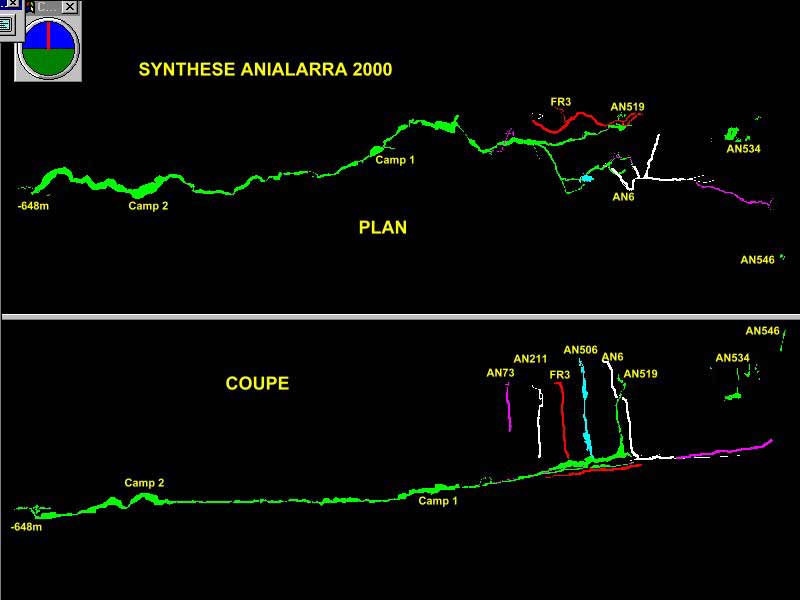
Cave radio’s
Finally we are proud to announce a "world premiere".
Two of the expedition members (Herman Jorens - Avalon and Erwin Lokhorst
- Speleo NL) are for many years now, into cave radio’s . They have build
several "Heyphones" (a wireless cave radio, designed by John Hey, UK)
and have made lots of modifications to the original design, in order
to make the radio’s more powerful (they transmit easily through 500
m of rock) and to make them fit for expedition use.
Cave radio’s are meant for use in cave rescues.
Their main problems are that:
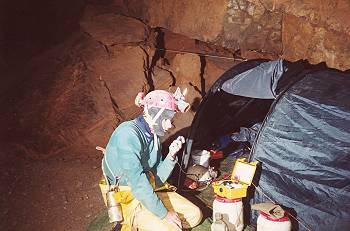 1)
the surface radio must be located more or less above the underground
radio, in order to obtain the shortest distance possible between them.
This is especially important when working at great depth, which was
the case (+/- 400 m of rock) here. But, this means that in big cave
systems, the surface radio will often be very far away from the entrance
of the cave. In our case, it was 3 kilometres away from the entrance
and/or altitude camp. 1)
the surface radio must be located more or less above the underground
radio, in order to obtain the shortest distance possible between them.
This is especially important when working at great depth, which was
the case (+/- 400 m of rock) here. But, this means that in big cave
systems, the surface radio will often be very far away from the entrance
of the cave. In our case, it was 3 kilometres away from the entrance
and/or altitude camp.
2) the surface radio must be manually operated.
This means that the operator will have to stay permanently near the
radio. In our case, a 2 hour walk through difficult terrain was necessary
to get to the radio. It was not possible to do this every day, or to
do this in the dark...
After many a night of thinking, puzzling, trying,
our two radio-freaks developed an electronic device that could play
the role of the operator. Even more: this device linked the cave radio
to a portable VHF-radio. Pressing or releasing the microphone-button
was not necessary: this was done automatically by this device. The portable
radio relayed the cave radio signals to any other VHF-radio. We had
one at the surface camp (near the cave entrance); one at the camping
in Ste-Engrace (18 km away and 1500 m. lower) and occasionally one at
the ski-station.
The cave-radio was installed "in the middle of
nowhere"; a spot in the "lapiaz" straight above the terminus of the
cave. A lead-battery, recharged permanently by means of a solar panel,
and a bigger antenna completed the whole lot. After the initial setup,
and the inevitable little problems to be solved, everything was then
abandoned for the next couple of weeks and functioned totally independent.
E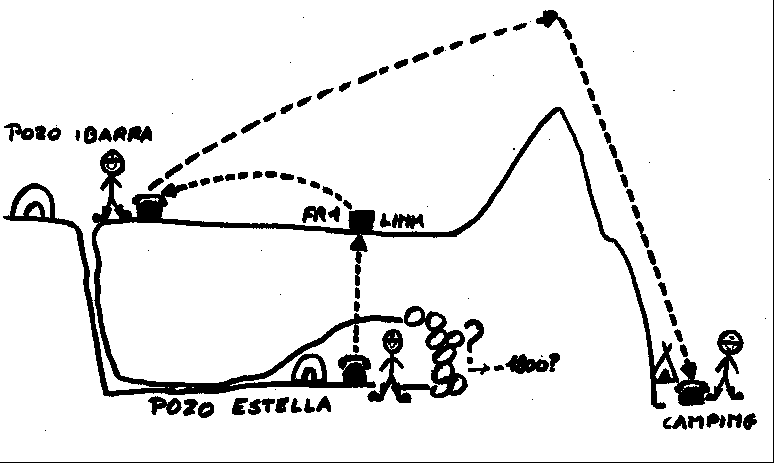 very
evening around 21:00 o’clock, the cavers in Camp 2 (-578 m) were able
to talk to their colleagues in the surface-camp and/or the ski-station.
Even the people at the camping could listen along. very
evening around 21:00 o’clock, the cavers in Camp 2 (-578 m) were able
to talk to their colleagues in the surface-camp and/or the ski-station.
Even the people at the camping could listen along.
When you are staying underground for three days
in a flood-prone cave system, it is just fantastic to be able to talk
to the wife and kids, to know what weather it is, and to exchange information
about the progress you’ve made with your fellow cavers. Thanks to this
daily communication, the performance of the teams greatly increased,
since the new team didn’t have to wait until the preceding team had
surfaced, e.g. to know what extra gear or food was needed in the camps.
As
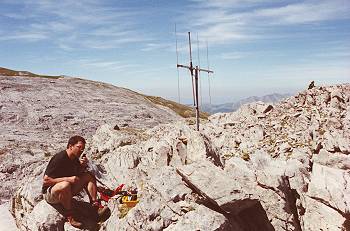 far
as we know, this was the very first time that cave-radio’s have been
used in this way (linked to normal radios); and we are proud and happy
that this historical event took place at the even more historical Pierre-St-Martin
massif. The proof is now there that cave-radios are more than just electronic
gadgets, only to be used during cave-rescues. Without doubt, the possibility
of interfacing a cave-radio with normal handsets will become a standard
functionality in alle cave-radio systems (Heyphone, Nicola etc.). far
as we know, this was the very first time that cave-radio’s have been
used in this way (linked to normal radios); and we are proud and happy
that this historical event took place at the even more historical Pierre-St-Martin
massif. The proof is now there that cave-radios are more than just electronic
gadgets, only to be used during cave-rescues. Without doubt, the possibility
of interfacing a cave-radio with normal handsets will become a standard
functionality in alle cave-radio systems (Heyphone, Nicola etc.).
Many thanks to Herman and Erwin, for all the ingenious
work they have done.
Conclusion
It was a successful expedition, not in the least
because of the great weather. But so much work remains to be done at
the beautiful and savage Anialarra massif; so we will definitely come
back soon!
Click here for
the report of the "Mini-expedition" in october 2000"
 Finally
we would like to thank de Berghut
in Hamme, who provided us with several quality tents (1 x
Northface, 1 x
Ferrino, 1x Fjalraven) Finally
we would like to thank de Berghut
in Hamme, who provided us with several quality tents (1 x
Northface, 1 x
Ferrino, 1x Fjalraven)
| 